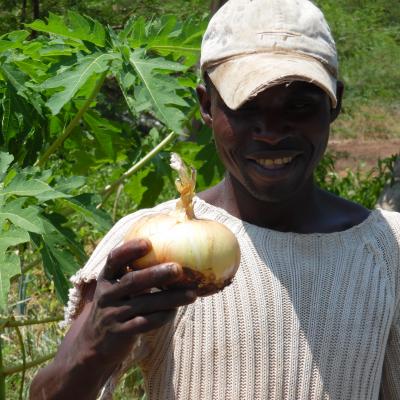CEDRIG Operativo
Informe PDFHorti-sempre: Increasing the income of smallholders through horticulture in the Nacala Corridor
Resumen
Información general
Autor
Michael Fink
Última actualización
Junio 2019
Objetivo general
Horti-sempre, Phase 2 overall objective is to increase the annual net income of 25,000 smallholders by 30% against baseline by supporting the growth of the horticultural sector in Northern Mozambique in view of its proven importance as income creator.
País
- Mozambique
Presupuesto
6,500,000 CHF
Duración
01/2017 - 12/2020
Resumen
Descripción
The overall objective of the Horti-Sempre Phase 2 Project is to increase smallholder’s annual net income by 30% against baseline by supporting the growth of the horticultural sector in Northern Mozambique in view of its proven importance as income creator. To fulfil its mission and reach the overall objective, Swisscontact proposes for Horti-sempre Phase 2 a logic of intervention based on three main Outcomes that unfold around three main project components namely (1) inputs and practices, (2) irrigation and (3) sector competitiveness. OUTCOME No 1: Productivity of horticultural smallholders in the Nacala Corridor in Northern Mozambique increased. OUTCOME No 2: Horticultural smallholders in the Nacala Corridor in Northern Mozambique increased their area under irrigation. OUTCOME No 3: Market responsiveness and competitiveness of the horti-cultural sector in Northern Mozambique is increased. The three components will be complemented with two transversal topics: Women’s Economic Empowerment (WEE) throughout the different interventions and through special women targeted interventions and access to existing funding options. Based on experience from Phase 1, Swisscontact estimates that Horti-Sempre Phase 2 has the potential to reach 10'000 semi-commercial and 15'000 subsistence male and female smallholders in Northern Mozambique increasing their income by up to 30%.
Sectores de Intervención
- Agricultura
- Seguridad alimentaria
- Desarrollo rural
- Gestión del agua
Documentos
Imágenes
-
 Training on affordable irrigation solution (hip-pump)
Training on affordable irrigation solution (hip-pump) -
 Affordable irrigation solution (hip-pump)
Affordable irrigation solution (hip-pump) -
 Construction of underground dam
Construction of underground dam -
 Underground dam (capacity to capture 10,000m3 water)
Underground dam (capacity to capture 10,000m3 water) -
 Improved lettuce variety Veneranda from Brazil under protected cultivation (mini-tunnel) with drip-irrigation system
Improved lettuce variety Veneranda from Brazil under protected cultivation (mini-tunnel) with drip-irrigation system -
 Improved onion vareity IPA 11 from Brazil adapted to tropical climate wtih longer shelf-life
Improved onion vareity IPA 11 from Brazil adapted to tropical climate wtih longer shelf-life -
 Training on good agricultural practices (tomato staking)
Training on good agricultural practices (tomato staking)
Logos



Perspectiva del riesgo
Amenazas que se producen debido a la degradación del medioambiente
Nombre de la amenaza
Degradación (tierra, suelo, ecosistemas, biodiversidad)
Consecuencia
Key consequences are lower yields due to degraded soil and higher need of farmers to use inputs (fertilizers); land conflicts possible
Grado
Perjudicial
Vulnerabilidades
Natural vulnerabilities due to overexploitation, soil compactation and erosion
Probabilidad
Probable
Importancia
Riesgo medio
Riesgo seleccionado
SíMedida seleccionada
SíMedida seleccionada
SíMedida seleccionada
SíNombre de la amenaza
Plagas y epidemias
Consecuencia
Key consequences are crop losses (sometimes failure) and that farmers avoid production in warmer and wetter months of the year
Grado
Perjudicial
Vulnerabilidades
Combined physical and financial vulnerability due to lack of availability and access to equipment and production tools; human vulnerability due to limited know-how on how to deal with pest and epidemics
Probabilidad
Probable
Importancia
Riesgo medio
Riesgo seleccionado
SíMedida seleccionada
SíMedida seleccionada
SíMedida seleccionada
SíMedida seleccionada
SíAmenazas naturales (hidrometeorológicas y geológicas)
Nombre de la amenaza
Olas de calor
Consecuencia
Key consequences include a shortening of the growing season, crop failure (no yield) or crop losses (lower yields) due to burning of plants
Grado
Perjudicial
Vulnerabilidades
Hardware bottlenecks: Physical vulnerabilities due to lack of agricultural equipment (irrigation schemes, protected cultivation, e.g. greenhouses) linked to financial vulnerability as no capacity to invest in adequate equipment; Software bottlenecks: human vulnerability due to lack of knowledge on available, affordable solutions such as heat tolerant seeds.
Probabilidad
Muy probable
Importancia
Riesgo alto
Riesgo seleccionado
SíMedida seleccionada
SíMedida seleccionada
SíMedida seleccionada
SíMedida seleccionada
SíMedida seleccionada
SíNombre de la amenaza
Crecidas repentinas, inundaciones
Consecuencia
Destruction of basic infrastructure and crops in early stage of growth, destruction of trade infrastructure (e.g. bridges and roads)
Grado
Sumamente perjudicial
Vulnerabilidades
Physical vulnerability due to poor protective infrastructure (e.g. dams); financial vulnerability due to limited cash for re-purchasing seeds, equipment and additional labour for re-sowing and land preparation
Probabilidad
Probable
Importancia
Riesgo alto
Riesgo seleccionado
SíMedida seleccionada
SíMedida seleccionada
SíAmenazas que se producen debido al cambio climático (y la variabilidad del clima)
Nombre de la amenaza
Cambios en las estaciones
Consecuencia
It is difficult for farmers to predict the start of the rainy season. Due to a delayed start of the rainy season, the growing cycle is postponed into the hot season when it is difficult to produce horticulture. Higher risk of pests due to humidity.
Grado
Perjudicial
Vulnerabilidades
Combined physical and financial vulnerability due to lack of availability and access to equipment and production tools; human vulnerability due to limited know-how on coping strategies to deal with erratic rainfall patterns
Probabilidad
Muy probable
Importancia
Riesgo alto
Riesgo seleccionado
SíMedida seleccionada
SíMedida seleccionada
SíMedida seleccionada
SíMedida seleccionada
SíMedida seleccionada
SíMedida seleccionada
SíMedida seleccionada
SíAdapte su proyecto
Perspectiva del impacto
Impacto negativo en el medioambiente
Componente del proyecto
Underground dams
Posible impacto negativo
Small-scale rainwater retention to increase soil humidity might potentially change the ecosystem; limited additional pollution due to the plastic used to build the dam
Componente del proyecto
Inputs (fertilizer & pesticides)
Posible impacto negativo
Use of fertilizer and pesticides by horticulture smallholders is common, and sometimes not correctly applied with negative impact on the soil (over-fertilizing)
Impacto seleccionado
SíMedida seleccionada
SíComponente del proyecto
Introduction of tropicalized varieties from Brazil
Posible impacto negativo
Introducing new horticultural crop varieties has the potential to seriously affect the biological balance in the country by introducing exotic diseases and harming local biodiversity.
Impacto seleccionado
SíMedida seleccionada
SíImpacto negativo en el cambio climático
Componente del proyecto
Increasing volumes and de-seasonalization of horticulture production
Posible impacto negativo
Possibly increasing emissions of Greenhouse Gases (GHG) due to increased local horticultural production and related transport volumes.
